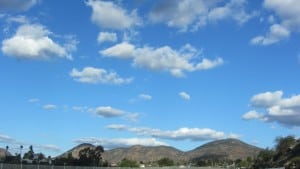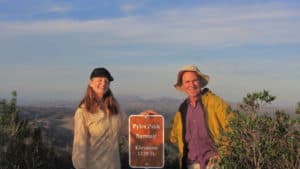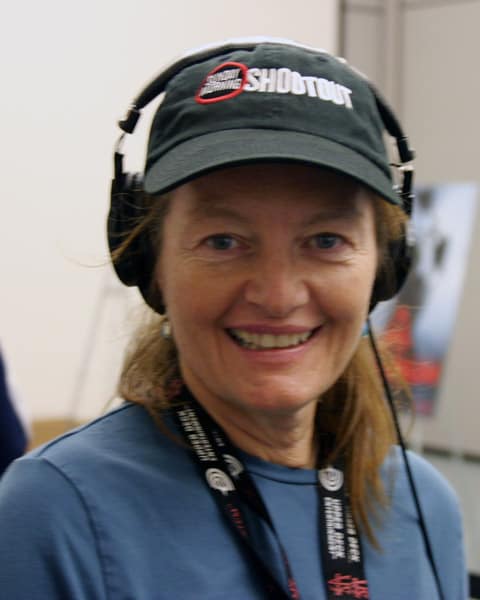Mission Trails Regional Park – San Diego’s Best-Kept Secret
Historical Overview
San Diegans are so fortunate to have Mission Trails right in our backyard!
Some of us are compelled to risk everything to reach the world’s highest peak, Mt. Everest. But those with more modest appetites – and budgets – don’t have far to travel to San Diego’s highest peak and crown jewel of Mission Trails, Cowles Mountain. Everyone calls it “cowls” but “coals” is the actual pronunciation. It was named after George Cowles, a prominent rancher originally from the East Coast. He and his wife, Jennie, settled in San Diego in 1877.
The couple owned over 4,000 acres in the El Cajon Valley. There they grew olive, fruit and magnolia trees, grapevines, grains and potatoes. Their success with fruits and vines was so great that Cowles was coined “Raisin King of the US.”
The Golden Triangle

We call Cowles Mountain, as seen from this angle “The Sleeping Lady;” here she is, lounging beneath cascades of clouds
Cowles Mountain is located ten miles northeast of downtown San Diego. The climb from the trailhead at Navajo and Golfcrest is a mile and a half. On top, you can thrill to 360-degree views of Lake Murray and our eastern mountain ranges. And to the west, you’ll spot La Jolla, Point Loma, downtown San Diego and even Los Coronados Islands, on a clear day. If you are up for it, continue on to Pyles Peak, just a mile and a half further.
I think of Cowles Mountain, Lake Murray and Mission Dam as San Diego’s “Golden Triangle.” This land comprises Mission Trails Regional Park. The park encompasses nearly 5,800 acres of land representing the way San Diego once was, before Juan Rodriguez Cabrillo arrived in 1542. Cabrillo and his crew were the first Europeans to set foot in Southern California.
The Kumeyaay
The Kumeyaay Indians occupied the land prior to the arrival of the Europeans. But the only evidence of them today are pottery shards and metates (grooves in stones used for grinding food). You’ll find many of these metates at a place dubbed “Grinding Rocks.” It’s a few hundred feet north of the Mission Trails Visitors Center along the San Diego River.
Mission Trails Interpretive Center
If you have never been to Mission Trails before, first check out the Visitors Center located at the intersection of Mission Gorge Road and Father Junipera Serra. We always bring our out-of-town guests here. Children always get a kick out of it, as will your inner child. As you approach the front entrance, you’ll hear the sounds of various birds. These are recordings from the wild, triggered as you walk by. A group of Kumeyaay elder statues greet you inside the center. A variety of stuffed animals reside there, including a bobcat, coyote, owl, raccoon, a couple of hawks, and a mountain lion. (The cougar is fabricated, but all other animals are real.) You’ll also enjoy displays of Kumeyaay history and culture.
We are proud to be an intrinsic part of the center’s latest exhibit, ‘Embers: The Hidden Threat.” We produced, shot and edited the video that is the centerpiece of the exhibit. In it, local geologist and television celebrity, Dr. Pat Abbott, explains how embers can cause catastrophic damage to your home from six miles and one hour away.
“Little Yosemite”
Our favorite view in the park overlooks Mission Gorge. This is Southern California’s “Little Yosemite” and is gorgeous. The center even has several viewing telescopes, and you can watch rock climbers on sheer granite walls. You might even spot hawks, rare checkered butterflies or bobcats.
According to Park Ranger Paul Seiley, “This is a Mediterranean climate with flora and fauna that can’t be found anywhere else in the world. People are certainly welcome to come and enjoy the park. But we’d like for them to stay on the established trails and away from rare and delicate species of plants that could easily be destroyed by crashing through the bushes.”
So please, don’t cut trails. And don’t step on the California sunflowers, laurel sumac, black sage, mission manzanita, mountain mahogany, or other varieties of plant life found in the Chaparral and Oak Woodland habitats of Mission Trails.
Your canine friend is welcome but must be on a leash. This will prevent potential contact with poison oak and rattle snakes. And don’t forget the plastic baggies. Paul adds, “If you’re going to hike with your dogs in the summertime, you should go early in the morning or late in the afternoon. Dogs don’t perspire like us. They lose their body heat by panting. So exposing them to the midday sun is not humane to the dog. It’s also a good idea to bring water for yourself and your pet.”
Five-Peak Challenge
 MTRP Board members wanted recreationists to know that Cowles is not the only mountain worth climbing in San Diego. So on November 7, 2015, MTRP kicked off the “Five-Peak Challenge.” The five peaks are: Cowles Mountain, Kwaay Paay, North Fortuna, South Fortuna and Pyles Peak. As of Friday, June 20, 2020 15,000 people had successfully completed the 5-Peak Challenge! Covid then shut down both Mission Trails Regional Park and the 5-Peak Challenge was suspended. Now that the pandemic is mostly in the rearview mirror, anyone can once again participate on hiking the 5 peaks (you don’t have to do them all in one day!) And as long as you can prove with photographs that you achieved those peaks, you can purchase a 5-Peak Challenge pin for $5.
MTRP Board members wanted recreationists to know that Cowles is not the only mountain worth climbing in San Diego. So on November 7, 2015, MTRP kicked off the “Five-Peak Challenge.” The five peaks are: Cowles Mountain, Kwaay Paay, North Fortuna, South Fortuna and Pyles Peak. As of Friday, June 20, 2020 15,000 people had successfully completed the 5-Peak Challenge! Covid then shut down both Mission Trails Regional Park and the 5-Peak Challenge was suspended. Now that the pandemic is mostly in the rearview mirror, anyone can once again participate on hiking the 5 peaks (you don’t have to do them all in one day!) And as long as you can prove with photographs that you achieved those peaks, you can purchase a 5-Peak Challenge pin for $5.
Enjoy your travels up, down and across the variegated trails of Mission Trails Grasslands, the five peaks and Lake Murray. And remember the adage, “Take only photos and leave only footprints.” This is the best way to enjoy our beautiful park that nurtures our spirit and refreshes our soul, for we are fortunate to have it.
If you are bringing plastic water bottles and snacks along on your hike, then take the empties and wrappers with you. Because it saddens those of us who adore these areas to see people leave garbage. It’s an affront to your fellow hikers and to Nature Herself.
Visiting San Diego? Try what we call a “Turf and Surf” – Hike up Cowles Mountain and then enjoy an evening aboard a Hornblower Dinner Cruise.
Patty Mooney is a VP, Video Producer, Sound Technician, Teleprompter Operator and Video Editor at award-winning San Diego Video Production Company, Crystal Pyramid Productions. For more adventures, enjoy our blog, Diary of a Video Production Crew

